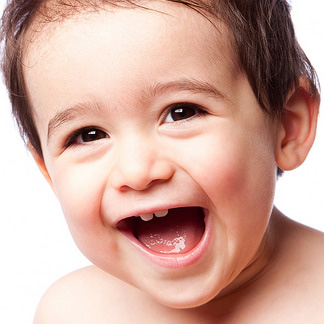Dental Care For Your Baby
Congratulations on the arrival of your baby! Are you prepared for the arrival of your baby's first tooth? Follow these guidelines and your son or daughter will be on the way to a lifetime of healthy smiles!
Caring for Gums
Even before your baby's first tooth appears, the gums can benefit from your careful attention. After breast- or bottle-feeding, wrap one finger with a clean, damp washcloth or piece of gauze and gently rub it across your baby's gum tissue. This practice both clears your little one's mouth of any fragments of food and begins the process for building good daily oral care habits.
Baby's First Tooth
When that first tooth makes an entrance, it's time to upgrade to a baby toothbrush. There are usually two options: a long-handled toothbrush that you and your baby can hold at the same time, and a finger-puppet-like brush that fits over the tip of your pointer finger. In each case, the bristles are soft and few.
At this stage, you may use childrens toothpaste with smear of fluoridated toothpaste. It does not take much! If your little one doesn't react well to the introduction of a toothbrush, don't give up. We can show you different techniques to assist in brushing at home.
Brushing with Toothpaste
When a few more teeth appear, you can start using toothpaste with your child's brush. At this stage, use only a tiny amount of toothpaste (a small smear - no more than a grain of rice) - there is no need to see foaming as we do when we brush our teeth. You may wipe the excess toothpaste off afterwards with a damp washcloth or piece of gauze.
Avoiding Cavities
Don't give your baby any sort of sweetened liquids such as flavored drinks or soda. Even the sugars present in fruit juice, formula, and milk (including breast milk) can cause decay, so regular teeth and gum cleaning is vital. Also, make sure your baby never goes to bed with a bottle; sugary liquids in prolonged contact with teeth are a guarantee for early-childhood decay, also called baby-bottle caries. We recommended delaying the introduction of juices until the age of 2!
First Visit to the Dentist
It's recommended that you bring your baby in for a visit with the eruption of the first tooth and no later than age 1. Since decay can occur in even the smallest of teeth, the earlier your baby visits us, the more likely he or she is to avoid cavities. We will look for any signs of early problems with your baby's oral heath, and check in with you about the best way to care for your little one's teeth. Remember that preparing for each dental visit with a positive attitude goes a long way toward making your child comfortable with regular checkups. We view parents as our partners and love to have your participation in each appointment!
Setting a Good Example
As part of the natural learning process, little ones are expert mimics, and you can take advantage of this talent. Brush and floss daily while your child is watching, and he or she will intuit at an early age the importance of your good habits. As soon as your child shows interest, offer a toothbrush of his or her own and encourage your toddler to “brush” with you. (You'll find toothbrushes with chunky, short handles that are easy to grip.) Most children don't have the dexterity necessary to thoroughly clean their own teeth until they're about six or seven, so you'll have to do that part of the job. Try different tactics to make brushing fun: flavored toothpaste, a toothbrush with a favorite character on it, or singing songs about brushing. The primary goal is to instill healthy oral habits at an early age to set your child up for a lifetime of healthy, cavity-free teeth!



 Website Powered by Sesame 24-7™
Website Powered by Sesame 24-7™